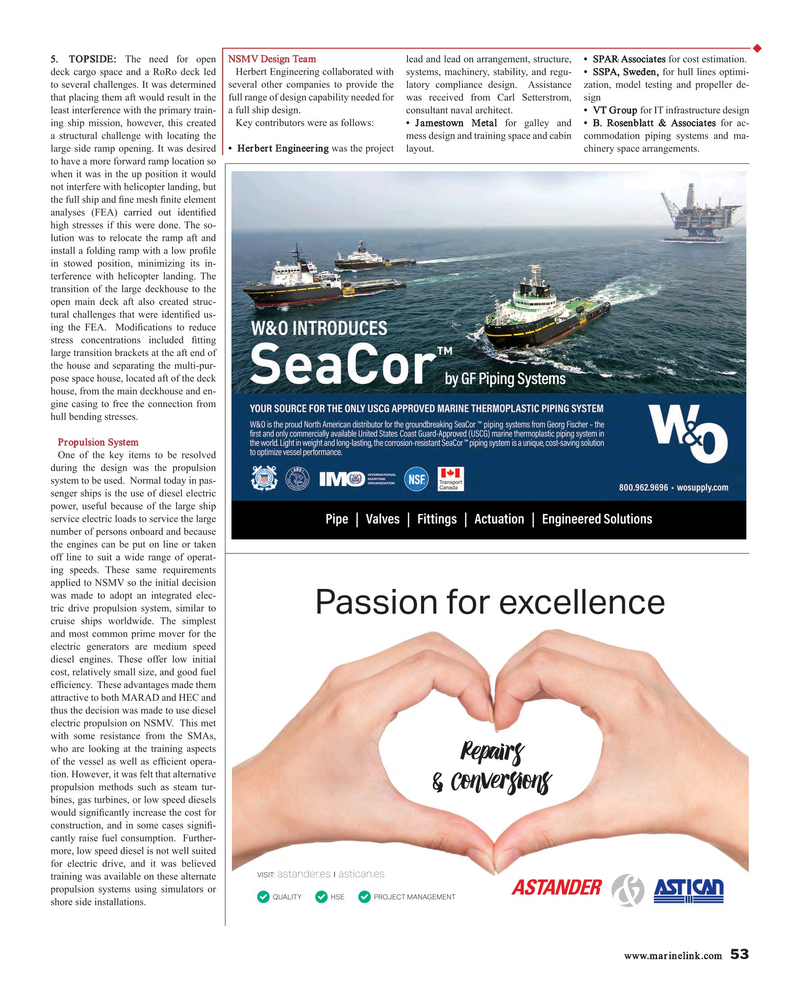
Page 53: of Maritime Reporter Magazine (August 2017)
The Shipyard Edition
Read this page in Pdf, Flash or Html5 edition of August 2017 Maritime Reporter Magazine
5. TOPSIDE: The need for open NSMV Design Team lead and lead on arrangement, structure, • SPAR Associates for cost estimation.
deck cargo space and a RoRo deck led Herbert Engineering collaborated with systems, machinery, stability, and regu- • SSPA, Sweden, for hull lines optimi- to several challenges. It was determined several other companies to provide the latory compliance design. Assistance zation, model testing and propeller de- that placing them aft would result in the full range of design capability needed for was received from Carl Setterstrom, sign least interference with the primary train- a full ship design. consultant naval architect. • VT Group for IT infrastructure design ing ship mission, however, this created Key contributors were as follows: • Jamestown Metal for galley and • B. Rosenblatt & Associates for ac- a structural challenge with locating the mess design and training space and cabin commodation piping systems and ma- large side ramp opening. It was desired • Herbert Engineering was the project layout. chinery space arrangements.
to have a more forward ramp location so when it was in the up position it would not interfere with helicopter landing, but the full ship and ? ne mesh ? nite element analyses (FEA) carried out identi? ed high stresses if this were done. The so- lution was to relocate the ramp aft and install a folding ramp with a low pro? le in stowed position, minimizing its in- terference with helicopter landing. The transition of the large deckhouse to the open main deck aft also created struc- tural challenges that were identi? ed us- ing the FEA. Modi? cations to reduce stress concentrations included ? tting large transition brackets at the aft end of the house and separating the multi-pur- pose space house, located aft of the deck house, from the main deckhouse and en- gine casing to free the connection from hull bending stresses.
Propulsion System
One of the key items to be resolved during the design was the propulsion system to be used. Normal today in pas- senger ships is the use of diesel electric power, useful because of the large ship service electric loads to service the large number of persons onboard and because the engines can be put on line or taken off line to suit a wide range of operat- ing speeds. These same requirements applied to NSMV so the initial decision was made to adopt an integrated elec- tric drive propulsion system, similar to
Passion for excellence cruise ships worldwide. The simplest and most common prime mover for the electric generators are medium speed diesel engines. These offer low initial cost, relatively small size, and good fuel ef? ciency. These advantages made them attractive to both MARAD and HEC and thus the decision was made to use diesel electric propulsion on NSMV. This met with some resistance from the SMAs, who are looking at the training aspects
Repairs of the vessel as well as ef? cient opera- tion. However, it was felt that alternative propulsion methods such as steam tur- & Conversions bines, gas turbines, or low speed diesels would signi? cantly increase the cost for construction, and in some cases signi? - cantly raise fuel consumption. Further- more, low speed diesel is not well suited for electric drive, and it was believed astander.es d astican.es
VISIT: training was available on these alternate propulsion systems using simulators or
QUALITY HSE PROJECT MANAGEMENT shore side installations. www.marinelink.com 53
MR #8 (50-57).indd 53 MR #8 (50-57).indd 53 8/8/2017 5:24:27 PM8/8/2017 5:24:27 PM

 52
52

 54
54
